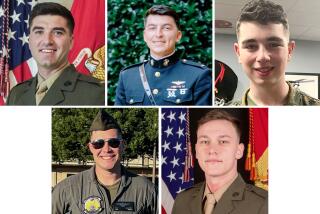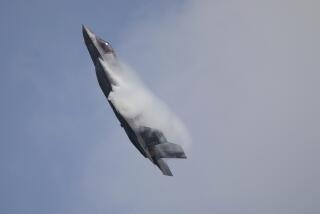RESCUE IN THE BALKANS : A Diet of Bugs, Rainwater, Hope
- Share via
ABOARD THE USS KEARSARGE — For almost six days, the downed pilot coolly hid in Bosnian Serb territory, living on bugs, rainwater and hope. Then, before dawn Thursday, as his strength ebbed, he directed his own rescue.
Wringing wet, filthy and hungry, he exploded in a run from the forest in Bosnia-Herzegovina, waving his pistol, sprinting as if the devil were behind him. He flopped onto the welcoming floor of a U.S. Marine helicopter with a whoosh of relief and tears in his eyes.
Air Force Capt. Scott F. O’Grady was safe, a “true American hero” in the words of President Clinton, and on his way to becoming a legend.
After nearly a week of fears about his fate, the 29-year-old U.S. pilot was back in American hands, rescued from behind the lines of the Serbian rebels in northwest Bosnia.
“I’m ready to get the hell out of here,” O’Grady told his rescuers, members of an elite Marine unit that flew from the amphibious assault ship Kearsarge in the Adriatic Sea.
Col. Martin Berndt, commander of the Marines who brought O’Grady out of the Bosnian wilderness, observed: “What a tremendous feeling as the sun was rising in a landing zone that was not as safe as I would have liked, to see him running through the bush, drenched with sweat and water with his pistol in his hand.”
The Marines had gone into Bosnia cautiously, sniffing for a trap: Hope for O’Grady had dimmed as day followed long day without word since his F-16 fighter was struck last Friday by a surface-to-air missile fired by the Serb rebels southwest of Bihac, and there was fear that Bosnian Serbs might be using his signaling device to lure rescuers into an ambush.
The rescue party did come under fire as it pulled out. Bosnian Serb gunners fired two surface-to-air missiles and lightly damaged one helicopter with automatic weapons fire.
But to hear the Marines aboard the Kearsarge tell the story, that is about all that went wrong on an all-American day in the Bosnian forest. The closest anybody got to getting hurt was when a bullet pinged harmlessly off a Marine’s canteen on the ride home.
Although searchers had determinedly looked for O’Grady since Friday, there was no sure sign he had survived the destruction of his Air Force jet fighter, according to officers on the Kearsarge.
The United States had been uncertain of O’Grady’s status partly because his wingman had been unable to see whether a parachute had come out of his aircraft after it had been hit.
O’Grady’s plane had been split by the SA-6 that hit it, and the section that contained the cockpit had disappeared into cloud cover before he could be seen ejecting.
“It was like looking for a needle in a haystack there,” one officer said of the five days’ of nonstop searching.
NEWS OF PILOT’S SURVIVAL
The evidence that O’Grady had survived came shortly after 2 a.m. Thursday.
A NATO reconnaissance plane circling over the Adriatic picked up an electronic distress signal from a mountain hillside not far from where O’Grady’s plane went down.
By 2:20 a.m., the signal was positively identified as coming from O’Grady, and by 3 a.m. the planning for the rescue mission was nearly complete, as ammunition was distributed to the Marines.
From Naples, NATO’s Southern Headquarters in Italy, U.S. Adm. Leighton Smith, the commander, told the Marines to go get Basher-52--O’Grady’s code name.
But the rescue mission commander had a hard choice.
The operation could be undertaken by helicopter at night, Smith explained later, and that would have the advantage of surprise--but the disadvantage of attempting to locate the pilot in the dark without the benefit of fighter protection.
Or the mission could arrive at dawn with the advantage of better visibility and an air umbrella--but perhaps without the element of surprise.
The Marine commander opted for a daylight rescue.
In Washington, National Security Adviser Anthony Lake told President Clinton, “It looks real tonight.”
It was about 9:30 p.m. Washington time, and Lake said, “It looks like a go.” (Bosnia is six hours ahead of Washington, nine hours ahead of California.)
“We’ve been training for this for nine months, and within two hours we were ready to go,” said Marine Lt. Col. Christopher Gunther, the mission commander.
RESCUE MISSION LAUNCHED
At 5 a.m, six minutes before dawn, the rescue team began lifting off the Kearsarge, which looks like a mini-aircraft carrier.
At 5:50, the rescue aircraft made their run: two CH-53 Super Stallion helicopters with two dozen handpicked Marines under 1st Lt. Martin Wetterauer; escort Cobra helicopters under Maj. Scott Mkyleby, and above them a pair of Harrier jets led by Maj. Michael Ogden.
North Atlantic Treaty Organization jets guarded from high above.
The Cobras found Basher-52 as they flew over dawn-lit hills obscured by fog in the valleys between them.
At 6:12 a.m., O’Grady made voice contact with Mkyleby on a UHF emergency radio with fading batteries. hey talked enough, an exchange of signs and counter-signs, for Mkyleby to be convinced that it really was O’Grady.
The word went out: Basher-52, alone out there in the middle of nowhere, was all right.
“He talked us on to the target, telling us where he was in relation to us as we got closer,” Mkyleby recalled on the Kearsarge flight deck Thursday afternoon.
The Cobras popped a yellow smoke grenade to mark a landing zone in an area of scrub pine on the rocky far side of a slope with no settlement anywhere near.
The two Super Stallions went in.
The Marines spilled out and headed for the tree line to hunt for O’Grady.
The rescue party would be on the ground for eight minutes: “It seemed longer than it was,” Berndt said.
O’Grady needed no invitation. Still wearing his helmet and flight suit, he came running, a 25-yard journey from fear to hope that will remain with the men who came to get him.
“He was running so fast. I was surprised he had so much energy after being out there like that for so many days,” said PFC Rashon Bennet of Newark, N.J.
“He came running up to the open door of the aircraft and I said, ‘We’re going to get you out of here,’ and suddenly he was in,” said Sgt. Scott Pfister of Canton, Ohio, the right gunner on the Super Stallion that would take O’Grady out.
“There were tears in his eyes when he came through that door,” said Cpl. Dwayne Koceja of St. Petersburg, Fla., the left gunner.
“When we hit the deck, he came running. He was tired, relieved, emotional,” Berndt said.
At 6:44 a.m., the Marines safely back aboard the helicopters, the rescue party took flight under the watchful eye of the Cobras and Harriers and headed back for the Kearsarge, 60 miles away.
MARINES UNDER FIRE
At 7:07, pilots saw tracks of two shoulder-fired, surface-to-air missiles. They jerked the helicopters so violently to evade them that several Marines vomited.
Automatic weapons fire damaged one chopper, a spent bullet bouncing off the canteen of Marine Sgt. Maj. Angel Castro.
Pfister returned the fire from his door gunner position. “We were about 20 or 30 clicks [kilometers] from the landing zone when the shooting started. I responded for effect to suppress it,” he said.
At 7:15, the rescue team reported a jubilant “feet wet” as they cleared land and were over the Adriatic.
At 7:30, a grinning O’Grady bounded from the helicopter onto the flight deck of the Kearsarge.
By 8, the entire mission was safely back aboard.
“When he came out of the helicopter, the first thing he did was to thank everybody he came across,” said Dr. Paul V. Rocerto, the Kearsarge’s medical officer.
“I asked him how he felt and he said, ‘I can’t feel any hurt anywhere.’ I asked him how he had survived in the wild and he said that after his emergency rations ran out--too quick--he had eaten bugs and grass and drunk rainwater,” Rocerto said.
“He had second-degree burns on his neck and cheek and bruises on the hips from the ejection. And he was dehydrated, but he’s in good shape,” he said.
And within five minutes, O’Grady was devouring an MRE--a military “meal-ready-to-eat,” which tastes a bit like toasted cardboard.
That “may tell you how hungry he really was,” Adm. William Owens, vice chairman of the Joint Chiefs of Staff joked later in Washington.
‘GOT ‘IM!’
At the White House, Lake called Clinton--it was shortly before 1 a.m. Washington time--with the news:
“Got ‘im!” Lake told the President.
“With or without your permission,” Lake told Clinton after filling him on the details of the rescue, “I’m going to smoke a cigar.”
“Come on over here,” Clinton said from the White House’s Truman Balcony, where the President had retreated to avoid breaking his wife’s no-smoking rules. “I’m having one on the balcony.”
Later, the President called O’Grady on the Kearsarge. “The country was on pins and needles, but you knew what you were doing,” he told the pilot.
The “real heroes,” O’Grady replied, were his rescuers.
“Mr. President, I just want to say one thing: The United States is the greatest country in the world. God bless America.”
Times staff writers Paul Richter and James Risen in Washington, William Tuohy in London and Art Pine in Brussels contributed to this report.
(BEGIN TEXT OF INFOBOX / INFOGRAPHIC)
5 Hours to Freedom
The rescue was mounted just after first light Thursday by an elite Marine Corps rescue team from the amphibious assault ship Kearsage.
PREPARATIONS
1) AWACS plane reports AC-130 gunship has confirmed sighting of O’Grady approximately 10 kilometers from where F-16 was shot down.
2) AWACS plane reports O’Grady is in good condition, but “he really needs to get out tonight and [his] radio [is] getting weak.”
3) Kearsarge is ordered to prepare to launch TRAP team, which is composed of Marines trained to recover aircraft and personnel.
4) Marine TRAP team takes off from Kearsarge. Weather condistions: scattered clouds, winds variable at 3 knots.
5) Area air commander reports launch of two F/A-18Ds charged with countering Serb air defenses.
6) Aircraft converge over Bosnia.
7) Rescue aircraft lands near downed pilot. O’Grady, weary with fatigue and starvation, dashes to helicopter.
8) Mission commander orders all aircraft to maintain radio silence.
9) U.S. aircraft report that Serbs are targeting them with their radar. Jammer aircraft maneuver to block their signals.
10) EA-6B radar-jammer asks that attack planes fire HARM missiles, which home in on targeting radar, at Bosnian Serb missile-launchers. Other planes continue to jam Serb radar.
11) Helicopters return to Kearsarge.
THE HERO HARDWARE
About the CH-53 Super Stallion helicopters that picked up the pilot: Length: 88 feet Height: 25 feet Range 257 miles Cruising speed: 173 m.p.h. Maximum altitude: 21,000 feet Capacity: 55 troops
COMPONENTS OF RESCUE FORCE
24th Marine Expeditionary Unit: 2,000-man force, many trained in special operations.
TRAP includes: 41-person Tactical Recovery of Aircraft and Personnel team 2 CH-53 helicopters, specially equipped for rescue efforts. 2 Cobra helicopter gunships. Specially trained search-and-rescue team.
SUPPORT TEAM Some of the NATO aircraft providing cover. 2 Air Force F-16 fighters 2 Navy EA-6B electronic surveillance planes 2 Air Force EF-111 radar-jamming planes 4 Marine Corps F/A-18D attack planes 1 Air Force AC-130 gunship.
Various AWACS planes to keep tabs on all aircraft in region.
* RELATED STORIES: A14
More to Read
Sign up for Essential California
The most important California stories and recommendations in your inbox every morning.
You may occasionally receive promotional content from the Los Angeles Times.










